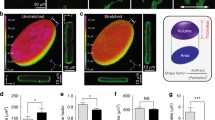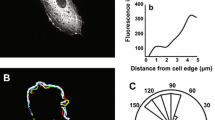Abstract
The intracellular mechanical link tethering the nucleus to the cytoskeleton has been suggested to be the linker of the nucleoskeleton and cytoskeleton (LINC) complex. Previous studies have reported that knockdown of nesprin-1, a component of the LINC complex that directly binds to actin filaments, suppresses cellular morphological response to mechanical stimuli. The relation between nesprin-1 knockdown and cellular morphological changes, however, remains unclear. In this study, we examined the mechanical role of nucleus–actin filament binding in morphological changes of fibroblasts exposed to cyclic stretching. After exposure to 10% cyclic stretching for 6 h, fibroblasts transfected with nesprin-1-specific small interfering RNA showed fewer elongated shapes compared with non-transfected cells. To further examine the mechanical role of the nucleus and nucleus-bound actin filaments, we applied cyclic stretching to fibroblasts treated with Trichostatin A (TSA), which decreases nuclear stiffness and thereby reduces nucleus-binding actin filament tension. TSA-treatment was found to induce more rounded cellular shapes than those of non-treated cells under both static and cyclic stretching conditions. These results suggest that the tension of nucleus-bound actin filaments plays an important role in the formation of elongated fibroblasts under cyclic stretching and that nesprin-1 knockdown causes a decrease of tension in nucleus-associated actin filaments.







Similar content being viewed by others
References
Anno, T., N. Sakamoto, and M. Sato. Role of nesprin-1 in nuclear deformation in endothelial cells under static and uniaxial stretching conditions. Biochem. Biophys. Res. Commun. 424(1):94–99, 2012.
Bashur, C., L. A. Dahlgren, and A. G. Goldstein. Effect of fiber diameter and orientation on fibroblast morphology and proliferation on electrospun poly(D,L-lactic-co-glycolic acid) meshes. Biomaterials 27(33):5681–5688, 2006.
Chancellor, T. J., J. Lee, C. K. Thodeti, and T. Lele. Actomyosin tension exerted on the nucleus through nesprin-1 connections influences endothelial cell adhesion, migration, and cyclic strain-induced reorientation. Biophys. J. 99(1):115–123, 2010.
Chang, Y. C., P. Nalbant, J. Birkenfeld, Z. F. Chang, and G. M. Bokoch. GEF-H1 couples nocodazole-induced microtubule disassembly to cell contractility via RhoA. Mol. Biol. Cell 19(5):2147–2153, 2008.
Chen, B., C. Co, and C. C. Ho. Cell shape dependent regulation of nuclear morphology. Biomaterials 67:129–136, 2015.
Crisp, M., Q. Liu, K. Roux, J. B. Rattner, C. Shanahan, B. Burke, P. D. Stahl, and D. Hodzic. Coupling of the nucleus and cytoplasm: role of the LINC complex. J. Cell Biol. 172(1):41–53, 2006.
Dahl, K. N., P. Scaffidi, M. F. Islam, A. G. Yodh, K. L. Wilson, and T. Misteli. Distinct structural and mechanical properties of the nuclear lamina in Hutchinson-Gilford progeria syndrome. Proc. Natl. Acad. Sci. USA 103(27):10271–10276, 2006.
Deguchi, S., T. S. Matsui, and K. Iio. The position and size of individual focal adhesions are determined by intracellular stress-dependent positive regulation. Cytoskeleton (Hoboken) 68(11):639–651, 2011.
Deguchi, S., T. Ohashi, and M. Sato. Intracellular stress transmission through actin stress fiber network in adherent vascular cells. Mol. Cell Biomech. 2(4):205–216, 2005.
Greiner, A. M., H. Chen, J. P. Spatz, and R. Kemkemer. Cyclic tensile strain controls cell shape and directs actin stress fiber formation and focal adhesion alignment in spreading cells. PLoS ONE 8(10):e77328, 2013.
Guilluy, C., R. Garcia-Mata, and K. Burridge. Rho protein crosstalk: another social network? Trends Cell Biol. 21(12):718–726, 2011.
Guilluy, C., L. D. Osborne, L. Van Langeghem, L. Sharek, R. Superfine, R. Garcia-Mata, and K. Burridge. Isolated nuclei adapt to force and reveal a mechanotransduction pathway in the nucleus. Nat. Cell Biol. 16(4):376–381, 2014.
Hayakawa, K., H. Tatsumi, and M. Sokabe. Actin stress fibers transmit and focus force to activate mechanosensitive channels. J. Cell Sci. 121(Pt 4):496–503, 2008.
Hoffman, L. M., C. C. Jensen, A. Chaturvedi, M. Yoshigi, and M. C. Beckerle. Stretch-induced actin remodeling requires targeting of zyxin to stress fibers and recruitment of actin regulators. Mol. Biol. Cell 23(10):1846–1859, 2012.
Huang, W., N. Sakamoto, R. Miyazawa, and M. Sato. Role of paxillin in the early phase of orientation of the vascular endothelial cells exposed to cyclic stretching. Biochem. Biophys. Res. Commun. 418(4):708–713, 2012.
Kataoka, N., S. Ujita, and M. Sato. Effect of flow direction on the morphological responses of cultured bovine aortic endothelial cells. Med. Biol. Eng. Comput. 36(1):122–128, 1998.
Katsumi, A., J. Milanini, W. B. Kiosses, M. A. del Pozo, R. Kaunas, S. Chien, K. M. Hahn, and M. A. Schwartz. Effects of cell tension on the small GTPase Rac. J. Cell Biol. 158(1):153–164, 2002.
Kaunas, R., P. Nguyen, S. Usami, and S. Chein. Cooperative effects of Rho and mechanical stretch on stress fiber organization. Proc. Natl. Acad. Sci. USA 102(44):15895–15900, 2005.
Khatau, S. B., C. M. Hale, P. J. Stewart-Hutchinson, M. S. Patel, C. L. Stewart, P. C. Searson, D. Hodzic, and D. Wirtz. A perinuclear actin cap regulates nuclear shape. Proc. Natl. Acad. Sci. USA 106(45):19017–19022, 2009.
Khatau, S. B., D. H. Kim, C. M. Hale, R. J. Bloom, and D. Wirtz. The perinuclear actin cap in health and disease. Nucleus 1(4):337–342, 2010.
Krause, M., J. Te Riet, and K. Wolf. Probing the compressibility of tumor cell nuclei by combined atomic force-confocal microscopy. Phys. Biol. 10(6):065002, 2013.
Lombardi, M. L., D. E. Jaalouk, C. M. Shanahan, B. Burke, K. J. Roux, and J. Lammerding. The interaction between nesprins and sun proteins at the nuclear envelope is critical for force transmission between the nucleus and cytoskeleton. J. Biol. Chem. 286:26743–26753, 2011.
Meinke, P., and E. C. Schirmer. LINC’ing form and function at the nuclear envelope. FEBS Lett. 589:2514–2521, 2015.
Mejat, A., and T. Misteli. LINC complexes in health and disease. Nucleus 1(1):40–52, 2010.
Neumann, F. R., and P. Nurse. Nuclear size control in fission yeast. J. Cell Biol. 179(4):593–600, 2007.
Oya, K., N. Sakamoto, T. Ohashi, and M. Sato. Combined stimulation with cyclic stretching and hypoxia increases production of matrix metalloproteinase-9 and cytokines by macrophages. Biochem. Biophys. Res. Commun. 412(4):678–682, 2011.
Prager-Khoutorsky, M., A. Lichtenstein, R. Krishnan, K. Rajendran, A. Mayo, Z. Kam, B. Geiger, and A. D. Bershadsky. Fibroblast polarization is a matrix-rigidity-dependent process controlled by focal adhesion mechanosensing. Nat. Cell Biol. 13(12):1457–1465, 2011.
Scaffidi, P., L. Gordon, and T. Misteli. The cell nucleus and aging: tantalizing clues and hopeful promises. PLoS Biol. 3(11):e395, 2005.
Shyy, J. Y., and S. Chien. Role of integrins in endothelial mechanosensing of shear stress. Circ. Res. 91(9):769–775, 2002.
Stewart-Hutchinson, P. J., C. M. Hale, D. Wirtz, and D. Hodzic. Structural requirements for the assembly of LINC complexes and their function in cellular mechanical stiffness. Exp. Cell Res. 314(8):1892–1905, 2008.
Tondon, A., and R. Kaunas. The direction of stretch-induced cell and stress fiber orientation depends on collagen matrix stress. PLoS ONE 9(2):e89592, 2014.
Tzima, E. Role of small GTPases in endothelial cytoskeletal dynamics and the shear stress response. Circ. Res. 98(2):176–185, 2006.
Varma, H., A. Yamamoto, M. R. Sarantos, R. E. Hughes, and B. R. Stockwell. Mutant huntingtin alters cell fate in response to microtubule depolymerization via the GEF-H1-RhoA-ERK pathway. J. Biol. Chem. 285(48):37445–37457, 2010.
Vishavkarma, R., S. Raghavan, C. Kuyyamudi, A. Majumder, J. Dhawan, and P. A. Pullarkat. Role of actin filaments in correlating nuclear shape and cell spreading. PLoS ONE 9(9):e107895, 2014.
Wang, N., J. D. Tytell, and D. E. Ingber. Mechanotransduction at a distance: mechanically coupling the extracellular matrix with the nucleus. Nat. Rev. Mol. Cell Biol. 10(1):75–82, 2009.
Acknowledgments
The present study was supported in part by Grants-in-Aid for Scientific Research from the Ministry of Education, Culture, Sports, Science and Technology (MEXT) of Japan (Nos. 15K01304 and 16K15837) and the interdepartmental research fund of Kawasaki University of Medial Welfare.
Conflict of interest
N. Sakamoto, M. Ogawa, K. Sadamoto, M. Takeuchi, and N. Kataoka declare that they have no conflicts of interest.
Ethical Standards
No human or animal studies were carried out by the authors for this article.
Author information
Authors and Affiliations
Corresponding author
Additional information
Associate Editor Kris Noel Dahl oversaw the review of this article.
Rights and permissions
About this article
Cite this article
Sakamoto, N., Ogawa, M., Sadamoto, K. et al. Mechanical Role of Nesprin-1-Mediated Nucleus–Actin Filament Binding in Cyclic Stretch-Induced Fibroblast Elongation. Cel. Mol. Bioeng. 10, 327–338 (2017). https://doi.org/10.1007/s12195-017-0487-6
Received:
Accepted:
Published:
Issue Date:
DOI: https://doi.org/10.1007/s12195-017-0487-6




